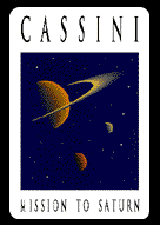Click on image for full size
NASA/JPL
Related links:
To Saturn We'll Go...
News story originally written on October 13, 1997
The last phase of approvals has ended for the Cassini mission as the White House Office of Science and Technology formalized its approval for the Cassini launch. Cassini was supposed to be launched from Cape Canaveral on October 13, 1997. Unfortunately, several problems have delayed the launch.The first problem was the weather at Kennedy Space Center. High upper-level winds exceeded launch safety parameters. There were also two mechanical problems on the day of the launch -- a glitch in a computer onboard Cassini and a problem with a piece of the rocket's ground support equipment. Apparently NASA has remedied the computer problem and the Air Force is hard at work to get ground support up to par. So if the weather cooperates, Cassini will be launched on Wednesday, October 15th.
The Cassini probe will travel 7 years to reach Saturn's complex system of moons and rings. The Cassini mission is to study Saturn, its magnetosphere, its atmosphere, and its rings. The spacecraft,equipped with 12 scientific experiments, will orbit Saturn for 4 years.
Much like Galileo before it, Cassini will carry an atmospheric probe that will parachute into Titan's thick atmosphere. Titan is Saturn's largest moon. Its thick atmosphere is nitrogen-based like the Earth's, so scientists are hoping to make connections between the two worlds.
The Cassini mission is a joint endeavour of NASA, the ESA, and the Italian Space Agency. The main mission will end in July 2008.















